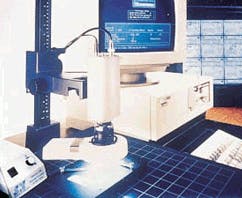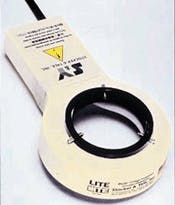BACK TO BASICS: Design guidelines for electrostatic-discharge-safe lighting
By George A. Fryburg
Electrostatic discharge (ESD)--the transfer of electrostatic charge between objects at different potentials--still remains an important product design challenge in many high-technology manufacturing and inspection environments. Small and sensitive electronic, semiconductor, and lighting products and materials especially mandate the need for the development and institution of ESD-protective practices and materials.
Protection from electrostatic discharge--which can be initiated either by triboelectrification through direct contact or induced by an electric field caused by a charged object--is crucial when working with ESD-sensitive devices. A device is considered ESD-sensitive based on its susceptibility to damage from an ESD event. Some electronic devices can be damaged from an electrostatic discharge of just 10 volts. The susceptibility of devices to ESD events is a major factor behind the design and advancement of ESD-protective manufacturing and inspection equipment.
In the competitive and ever-changing high technology electronics marketplace, the demand for ESD-protective industrial process equipment becomes significant in order to yield greater manufacturing throughput and increased product reliability. Classified as either conductive or dissipative, ESD protective materials limit the generation of electrostatic charges, dissipate electrostatic charges, or provide shielding from electric fields.
ESD-safe equipment
The consequences of working without ESD-safe equipment can be devastating to sensitive products. In the late 1970s, component and system failures due to ESD events in the electronics industry escalated almost exponentially. Fortunately, manufacturing facilities thoroughly investigated the problem and consequently implemented appropriate static-control programs. Even today, industry data disclose that ESD failures still account for 10% to 30% of all semiconductor failures. Conversely, manufacturing studies prove conclusively that implementing an ESD-control program enhances production yields and increases product reliability in the field.
Microscopy and machine-vision processes are important areas where an ESD-safe equipment is required to protect sensitive parts and preserve the integrity of the manufacturing process. Given the sensitivity of the components utilized within these processes, company investments in ESD-safe equipment readily pay off in terms of productivity gains and end-product reliability.
In sum, all of the components utilized in product assembly must be ESD-protective within the work area. This meansall components. The popularity of workbenches with ESD-protective finishes is evidence of this trend, as is the preponderance of ESD-safe tools.
Included in the total work environment, though often overlooked, is ESD-protective lighting products. In high-quality ESD lighting products, the entire lighting system must limit static-charge buildup to near zero-volt levels.
Figure 1. Because of the operating sensitivity of the components used in microscopy and machine-vision applications, companies must install electrostatic discharge (ESD)-safe lighting equipment to yield increased manufacturing throughput and product reliability.
Close attention to product materials and treatments will ensure that all surfaces of the illumination system in the working area maintain static dissipative properties. Of course, once the decision has been made to switch to ESD-safe lighting, system designers must consider certain critical product features above and beyond its ESD-safe characteristics. Actual lighting product quality and output are essential. High-quality light output can be measured by various standards, and is dictated by certain applications. More importantly, the lighting product should generate acceptable levels of lumens to support virtually all microscopy and machine-vision system applications (see Fig. 1).
Figure 2. The Model 10 Circular Fluorescent Microscope Illuminator from Stocker & Yale is designed for ESD-safe lighting performance. Early ESD properties were limited to exterior static dissipative coatings. This illuminator incorporates an ESD-safe housing, cord, and lamp.
For example, consider the Stocker & Yale (Salem, NH) ESD-safe Model 10 Circular Fluorescent Microscope Illuminator (CFMI); see Fig. 2). The first-generation of this product took the approach of applying an engineered static dissipative coating to the exterior surfaces of the lamp fixture. The surface resistance measured between 107 ohms and 109 ohms which, at the time, was within the required range of performance. However, the interior surfaces of the lamp fixture and the lamp itself remained without a dissipative coating for the purpose of maintaining light output levels between 130 foot-candles and 2100 foot-candles within a 3-to 12-in. working distance.
Because it was apparent that not all components of the CFMI system were ESD-safe, those same components were being redesigned in a parallel research and development effort for the second generation of the product. To reduce the chance of an ESD event occurring between the lamp and the specimen being inspected, a proprietary, clear dissipative coating was applied to the lamp; this coating achieved a surface resistance of 109 ohms to 1011 ohms.
Unfortunately, the application of this coating reduced the lamp's light output. To solve this problem, a highly reflective metal was sputtered onto the interior surface of the lamp fixture to regain ideal light output/lumen levels. The same clear dissipative coating was even applied to the product labels.
For the fixture cable, an engineered elastomer was compounded and extruded over the conductors. The result was a cable jacket with a surface resistance of 109 ohms to 1011 ohms. A ground was implemented to drain the charge from the lamp fixture. The lamp support was fabricated from a conductive elastomer with a surface resistance of between 104 ohms and 106 ohms. Subsequently, at the end of this development cycle, the entire CFMI light system was specified as ESD-safe.
Key ESD features
For microscopy and machine-vision applications, the important ESD-safe features depend on the specific use, as well as the specific ESD-safe lighting technology desired. Some key benefits are listed for the leading lighting technologies available today in the microscopy and machine-vision industries.
Fluorescent Lighting
- 360° of uniform bright white light
- Shadowless, flicker-free illumination
- 6000 Kelvin color temperature
- Long lamp life--some over 7000 hours
- Electronic ballast
- Brighter light for true color balance
- Easy, lightweight mounting
Fiberoptic Lighting
- 360° shadow-free, glare-free lighting
- Variable intensity with steady color
- Remote lighting capabilities
- Oblique lighting to enhance surface detail
- True color balance over a wide brightness range
- No electrical connection at the point of process
- Easy, lightweight mounting in restricted spaces
Light-Emitting Diodes (LEDs)
- Long life, up to 100,00 hours
- High density illumination
- -±10% output uniformity or better
- Minimum current draw/energy efficient
- Focused, cool illumination
- Monochromatic available in different wavelengths
- Can be computer-controlled
Because of the growing sensitivity of electronic components (for example, magnetic-resistive heads in disk drives), the need for ESD-safe lighting solutions continues to proliferate. In fact, design requirements are beginning to call for higher conductivity on ESD-protective products due to the ever-increasing static sensitivity of the components they produce and the involved tools. Yet, with technology evolving so rapidly--and because product development is driven in large part by market needs--it's difficult to predict just how stringent the resistance to ground requirements has to be specified.
However, creating an ESD-safe environment is not solely dependent on the ESD-safe lighting solution used. Several other design elements must be considered in establishing an ESD-safe environment:
- Air Ionizers: Send out a mixture of positive and negative electrons into the air around a workstation to neutralize any possible static build-up.
- Products/Components: All of these should be ESD-compliant. If they are not, use anti-static treatments (liquids and sprays) to make a product static-dissipative. Unfortunately, these treatments wear out due to excessive handling; consequently, integrity can be diminished. Look for ESD-safe materials that are guaranteed for the life of the product.
- Environment: Headwear, floorings, chairs, uniforms, tables, and wrist straps should all be static dissipative.
- Handling Equipment: Tote and shipping containers should also be ESD-compliant or static dissipative. For example, IC chips should be shipped in a dissipative material.
- Testing Equipment: Several ways are available to test for resistance measurements (that is, to determine static-dissipative or conductive qualities). These include electrode assembly, specimen support service, or instrumentation, such as a power supply attached to a current-measuring meter.
Making a manufacturing or inspection environment 100% ESD-safe can, in some cases, be nearly impossible to achieve. Yet, by examining every way that ESD can be generated within a product operation--including lighting--and taking the proper steps to manage it, system designers can minimize ESD effects, increase product reliability, and save product costs.
George A. Fryburg is responsible for Stocker & Yale's Salem, NH, and Stilson, MI, divisions.


